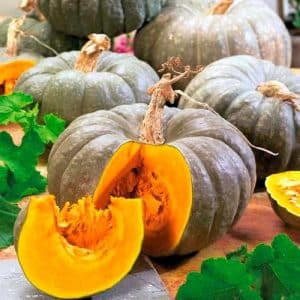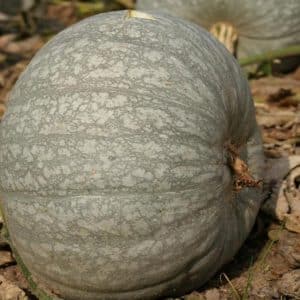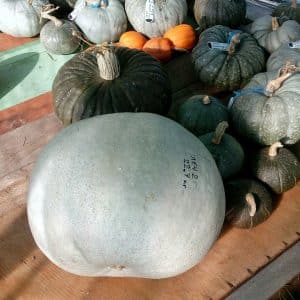A healthy and tasty variety from Kuban breeders - “Medicinal” pumpkin: review of the variety and instructions for growing
Pumpkin is distinguished by its ease of care and increased shelf life of the fruit. They are easily stored all winter in a dry, warm place and are considered one of the few inexpensive sources of vitamins in the cold.
Medicinal pumpkin is one of the most useful representatives of melons and melons. It is distinguished by its rich composition, versatility of use and much more. Read about all the advantages of the old-time variety and its cultivation in our article.
Description of the variety
Medicinal pumpkin is one of the most famous varieties bred by Kuban breeders. It was included in the Russian state register in 1994. The variety is recommended for cultivation in all regions of our country in open ground.
Medicinal seeds collected from our own harvest are suitable for growing. They are selected from the pulp of fruits ripened on the bush, dried in a warm place and store in fabric bags. The shelf life of pumpkin seeds is at least six years.
Distinctive features
The main feature of the Medicinal pumpkin is its fruit. They have a green crust covered with a white coating. This makes the pumpkins appear bluish.
The fruit pulp of this variety is juicy and sweet. It contains a large amount of fiber and nutrients. Among them, the concentration of vitamins A, E, and group B is especially high.
Another characteristic feature of Medicinal pumpkin is its resistance to temperature changes.The variety is not afraid of cold weather and is suitable for growing in open ground even in the northern regions of the country.
Pumpkin is also drought resistant. Despite this, with regular watering, its yield increases significantly and the taste of the fruit improves.
Reference. Pumpkin is low allergenic, so it is recommended for baby food.
Characteristics
Medicinal pumpkin is easy to grow. At the same time, it is characterized by high productivity and other positive characteristics.
Description of Medicinal Pumpkin:
| Options | Indicators |
| Bush type | Short climbing plant. The lashes are short, but thick. Bushes of medium power. The stems are round, hard, without ribbing, rough to the touch. The leaves are green, large, without dissection, and have the shape of a pentagon. The stalk is cylindrical. Bee-pollinated variety. The flowers are yellow, large with five petals. Ovaries are formed on female inflorescences. |
| Fruit | Pumpkins are large. Weight varies between 3-6 kg. Record specimens reach a mass of 9 kg. They have a round shape, slightly flattened on both sides. There is faint ribbing throughout the entire area of the pumpkins. There are fruits with light green and light gray rinds, on which there is a darker mesh pattern. The pulp is bright orange, juicy and dense. The taste is sweet with a pronounced pumpkin aroma. Each fruit has three cavities with white round seeds that are suitable for planting. |
| Ripening time | Early variety. The first fruits ripen 95-100 days after sowing the seeds. |
| Transportability | High. The fruits have a dense crust that protects them when transported over long distances. Pumpkin can be stored for up to three months. |
| Productivity | High. Up to 20 kg of harvest is obtained from one bush.Up to four pumpkins ripen on one plant. |
| Immunity | Is immune to viral diseases of melons and melons. Not resistant to fungal infections. |
Note! According to gardeners, the Medicinal variety is often affected rotten.
How to grow
Medicinal pumpkin is characterized by resistance to temperature fluctuations. It is grown in open ground in all regions of the country. This variety can withstand cold temperatures down to +2°C. At lower temperatures, the pumpkin stops growing.
Despite its cold resistance, Medicinal is photophilous. For it, they choose the sunniest area of the garden, where other representatives of melon crops have not previously grown.
In the fall, the beds are dug up and cleared of vegetation. The dug up greens are crushed and buried in the ground. Also for every 1 sq. m of plot, 6 kg of manure is applied.
If the acidity of the soil is increased, it is reduced with the help of ash or dry lime. It is recommended to add sand to heavy soil.
Advice. The acidity of the soil is checked with litmus paper. If it is not there, take the wet soil into a glass and add a small amount of soda to it. If bubbles appear, it means the acidity levels are high.
In spring, the beds are leveled with a rake and cleared of weeds. For each square meter, add 25 g of superphosphate and 20 g of urea. The beds are watered with a hot solution of copper sulfate prepared from 1 tbsp. l powder and 10 l water.
Landing
Medicinal plants are grown in seedlings and without seedlings. Seed is suitable only for the southern regions. In this case, the fruits appear much later than when seedlings are planted in the ground. Therefore, in areas with short summers it simply will not be possible to get a harvest.
Regardless of the growing method, the seeds must be prepared. This increases the resistance of plants to unfavorable factors and accelerates the germination of planting material:
- The seeds are calibrated - the largest and densest specimens are selected. It is important that their shell has a uniform light color.
- The planting material is heated - either soaked for 3 hours in water at a temperature of +50°C (all this time the liquid should not cool), or placed in an oven at +20°C for 5 hours, increasing the temperature by 10°C every hour.
- The seeds are germinated: wrapped in damp gauze and placed in a deep container. It will take 3-4 days for the seeds to hatch. All this time, as the fabric dries, add warm water.
- The seeds are hardened by placing them in the refrigerator for 48 hours.
Seeds
In the second half of May, seeds are sown in open ground. By this time, the soil temperature at a depth of 15 cm should not be lower than +15°C.
Dig holes 30 cm deep. Place a 10 cm layer of humus or rotted manure at the bottom. The rest of the space is filled with garden soil. For planting, a 60×80 pattern is used.
Three seeds are sown in each hole as far apart as possible. One is buried by 6 cm, the second by 8 cm, and the third by 10 cm.
The holes with seeds are watered. The beds are covered with film. Remove it a week after germination. When all the seeds have sprouted, pinch off the weaker stems. There should be one plant left in each hole.
Seedlings
Seeds for seedlings are sown in the second half of July. Plants are transplanted into open ground after two weeks.
Pumpkin seeds are sown immediately in individual containers, since the crop does not tolerate picking.They use plastic or peat pots, as well as improvised containers, such as juice boxes, cut-off bottles, and even dry pumpkins without pulp.
For pumpkin seedlings, fertile but loose soil is used. A purchased universal mixture for seedlings is suitable. You can prepare the soil yourself by mixing garden soil, humus and sand in a ratio of 1:1:0.5. A glass of ash and a matchbox of superphosphate are added to the bucket of the mixture. Drainage (coarse sand) is poured into the bottom of the containers, and the rest of the volume is filled with pre-prepared soil.
Advice. Containers, soil and drainage are disinfected with a dark pink solution of potassium permanganate.
Two seeds are planted in each pot, deepened by 3-4 cm.
Before the seeds germinate, the soil is moistened with warm water from a spray bottle. This is done only 2-3 times a week. It is important that the seedlings do not stand in a draft.
If both seeds germinate, one of the stems is removed. In order not to damage the root system of the seedlings, the unnecessary plant is not pulled out, but cut or pinched.
Before seeds germinate, the room temperature should be at least 27°C. A week after germination, the temperature is reduced to 15-18°C for a week. The plants are then grown at room temperature.
Feed pumpkin seedlings only once during the entire period. Use a solution of “Nitrophoska” or chicken manure (1:10 with water).
Three weeks after sowing the seeds, the seedlings are transplanted to a permanent place. By this time, the plants should have three true leaves. Short internodes indicate the high quality of seedlings.
A week before transplanting into the ground, the seedlings are hardened off. To do this, she is taken outside every day.
The holes are dug in a checkerboard pattern using a 60x80 pattern.1 liter of chicken manure solution is poured into each cavity. One plant at a time is planted in each hole. The root collar is not buried. Plantings are watered with warm water using the rain method. During the first week after picking, the beds are covered with film at night.
Caring for mature plants
During the growing process, the pumpkin must be watered regularly. The soil is moistened as the top layer dries. At 1st century m use at least 7 liters of warm, settled water. After each watering, the soil is loosened. During this procedure, weeds must be removed.
Fertilizers are applied every two weeks. Alternate solutions of Nitrophoska, chicken manure and ash. Before fertilizing, the plants are watered abundantly.
The side stems must be pinched. The growth of the main stem is limited after 2-3 fruits appear on it. This procedure is carried out when the sun is inactive. On the day of planting, the pumpkin is not watered.
Possible difficulties
When growing pumpkins, beginning gardeners often face a number of difficulties. The list contains the most common of them:
- The seedlings are lethargic or the seeds do not germinate. This problem usually occurs if cold water is used for watering or the pots are in a draft.
- Growth retardation is noticeable. Usually the reason lies in poor soil. Additional fertilizing will help correct the situation.
- Few ovaries are formed. Attracting pollinating insects will help. To do this, the bushes are sprayed with sweet water. Another option is to pollinate the female inflorescences yourself by combining them with the male ones.
- Pumpkins take a long time to ripen. This happens if they are in the shade of their own leaves. To correct the situation, some of the greenery will have to be removed.
- Pumpkin produces a large amount of greenery and few ovaries.This means the plant is fattening. It is necessary to reduce the amount of fertilizing.
Advice from experienced gardeners
To get a rich harvest and avoid many problems, you should listen to the advice of experienced gardeners:
- The beds are mulched with humus or straw. This layer protects plant roots from unfavorable conditions and suppresses weeds. The nutrient substrate harbors earthworms that loosen the beds.

- Before the inflorescences appear, the pumpkin is watered with rain. Then water is poured only at the root. When the fruits form, stop watering. This makes the pumpkins sweeter.
- To prevent the fruits from rotting, wooden supports are placed under them.
- The main stem is sprinkled with earth in one place. This promotes the formation of new roots.
Diseases and pests
Medicinal pumpkin has low resistance to fungal infections. To reduce the likelihood of infection, plants are sprayed once a week with a light pink solution of potassium permanganate or copper sulfate. Bordeaux mixture helps in the fight against existing diseases. However, it is effective only in the initial stages; in a neglected state, plants are simply pulled out and thrown away.
It is extremely important to follow the rules of disease prevention. They consist of disinfecting all materials and tools that come into contact with plants, observing crop rotation, watering and planting rules.
To protect the pumpkin from insects, the leaves are sprinkled with ash. Spraying with a soap solution and a decoction of wormwood also helps.
Harvesting and application
Harvesting medicinal pumpkint in August. Pumpkins are cut together with the stalk. Store in a dark and cool place.
The ripeness of pumpkins is indicated by a dry, hard stalk, hard crust and yellowed leaves.The fruits should not have bright green spots. A ripe harvest is characterized by a whitish coating.
Medicinal pumpkin is universal in use. It is suitable for desserts and main courses.
Use in folk medicine
Since ancient times, folk medicine has attributed to pumpkin healing properties. It is used as a mandatory product in the diet in the treatment of vitamin deficiency, liver and kidney diseases.
Cosmetologists make face and hair masks from pumpkin. They soften the skin and promote its rejuvenation.
Advantages and disadvantages of the variety
Benefits of Therapeutic:
- large and beautiful pumpkins;
- juicy sweet pulp, high in nutrients;
- immunity to viral diseases;
- compactness of the bush;
- cold resistance;
- keeping quality of fruits;
- high productivity;
- early ripeness.
The disadvantage of the variety is poor resistance to fungal infections.
Farmer reviews
Reviews about Medicinal Pumpkin are positive. People like its high yield and beautiful fruits.
Tamara, Valuiki: “I have been growing Medicinal for about 7 years now. It is easy to care for, but requires frequent feeding. To avoid the hassle of frequent fertilization, I set up pumpkin patches directly on the compost heap. Pumpkins grow beautiful and very tasty; they are stored in the cellar for a long time. The harvest from two bushes is enough for the whole family.”
Evgeniy, Moscow: “Medicinal pumpkin is my favorite pumpkin variety. I really like its bluish fruits, they are the same as in the photo. They have tasty pulp and seeds. They say they are very useful."
Conclusion
Medicinal pumpkin will appeal to both experienced and novice gardeners. This variety is not afraid of cold weather and viral infections. All that is required is to apply fertilizing in a timely manner and follow the rules for the prevention of fungal diseases.
Pumpkins look unusual.They have not a yellow, but a green crust with a dense white coating. In addition to their interesting appearance, the Medicnic fruits are distinguished by their rich sweet taste and high content of nutrients in their composition.